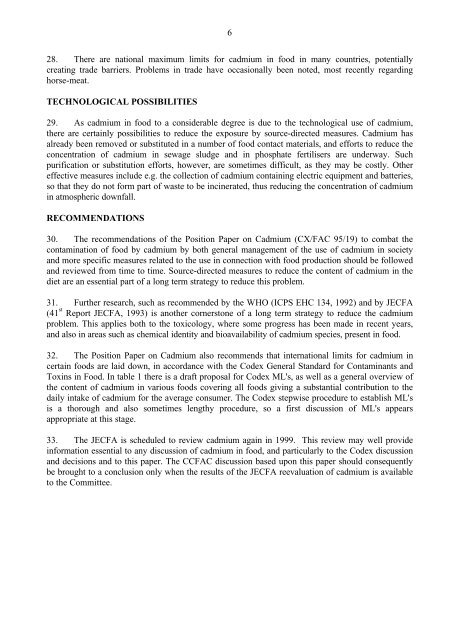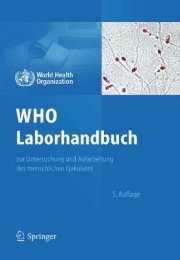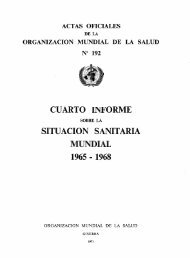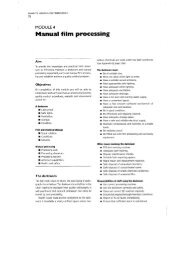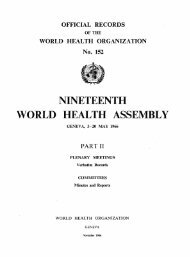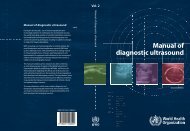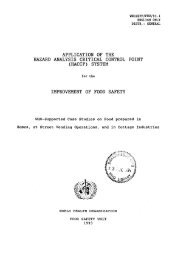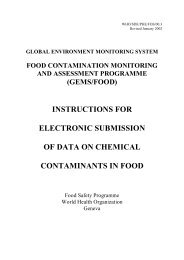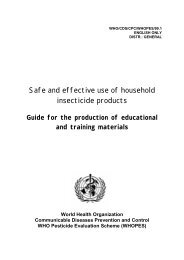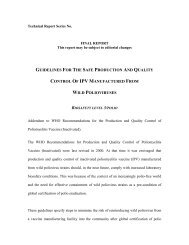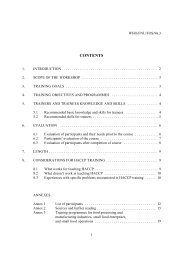CX/FAC 99/21 - World Health Organization
CX/FAC 99/21 - World Health Organization
CX/FAC 99/21 - World Health Organization
You also want an ePaper? Increase the reach of your titles
YUMPU automatically turns print PDFs into web optimized ePapers that Google loves.
6<br />
28. There are national maximum limits for cadmium in food in many countries, potentially<br />
creating trade barriers. Problems in trade have occasionally been noted, most recently regarding<br />
horse-meat.<br />
TECHNOLOGICAL POSSIBILITIES<br />
29. As cadmium in food to a considerable degree is due to the technological use of cadmium,<br />
there are certainly possibilities to reduce the exposure by source-directed measures. Cadmium has<br />
already been removed or substituted in a number of food contact materials, and efforts to reduce the<br />
concentration of cadmium in sewage sludge and in phosphate fertilisers are underway. Such<br />
purification or substitution efforts, however, are sometimes difficult, as they may be costly. Other<br />
effective measures include e.g. the collection of cadmium containing electric equipment and batteries,<br />
so that they do not form part of waste to be incinerated, thus reducing the concentration of cadmium<br />
in atmospheric downfall.<br />
RECOMMENDATIONS<br />
30. The recommendations of the Position Paper on Cadmium (<strong>CX</strong>/<strong>FAC</strong> 95/19) to combat the<br />
contamination of food by cadmium by both general management of the use of cadmium in society<br />
and more specific measures related to the use in connection with food production should be followed<br />
and reviewed from time to time. Source-directed measures to reduce the content of cadmium in the<br />
diet are an essential part of a long term strategy to reduce this problem.<br />
31. Further research, such as recommended by the WHO (ICPS EHC 134, 1<strong>99</strong>2) and by JECFA<br />
(41 st Report JECFA, 1<strong>99</strong>3) is another cornerstone of a long term strategy to reduce the cadmium<br />
problem. This applies both to the toxicology, where some progress has been made in recent years,<br />
and also in areas such as chemical identity and bioavailability of cadmium species, present in food.<br />
32. The Position Paper on Cadmium also recommends that international limits for cadmium in<br />
certain foods are laid down, in accordance with the Codex General Standard for Contaminants and<br />
Toxins in Food. In table 1 there is a draft proposal for Codex ML's, as well as a general overview of<br />
the content of cadmium in various foods covering all foods giving a substantial contribution to the<br />
daily intake of cadmium for the average consumer. The Codex stepwise procedure to establish ML's<br />
is a thorough and also sometimes lengthy procedure, so a first discussion of ML's appears<br />
appropriate at this stage.<br />
33. The JECFA is scheduled to review cadmium again in 1<strong>99</strong>9. This review may well provide<br />
information essential to any discussion of cadmium in food, and particularly to the Codex discussion<br />
and decisions and to this paper. The CC<strong>FAC</strong> discussion based upon this paper should consequently<br />
be brought to a conclusion only when the results of the JECFA reevaluation of cadmium is available<br />
to the Committee.


